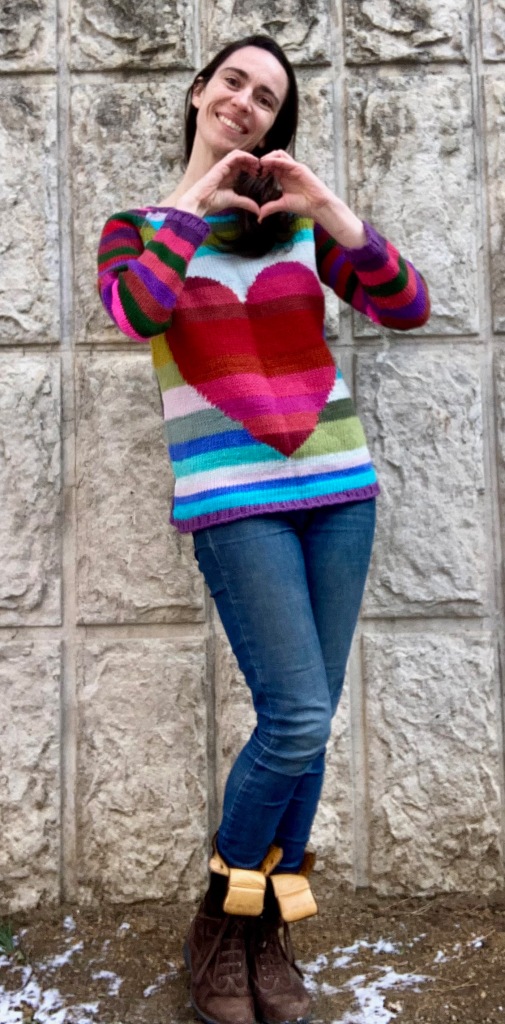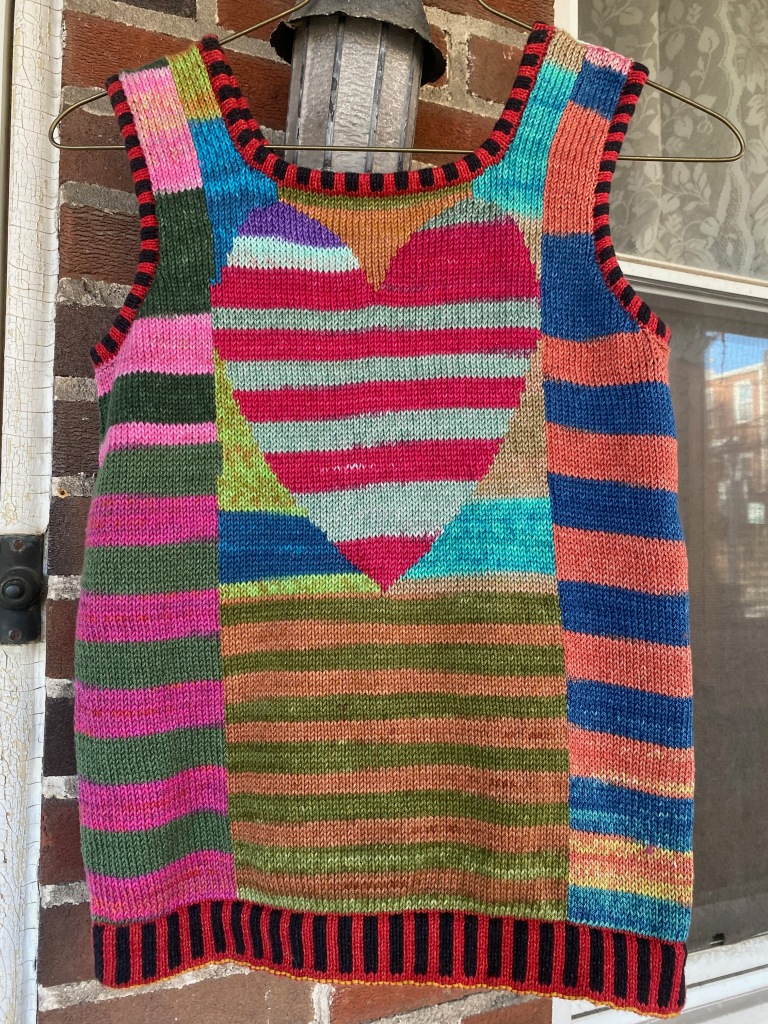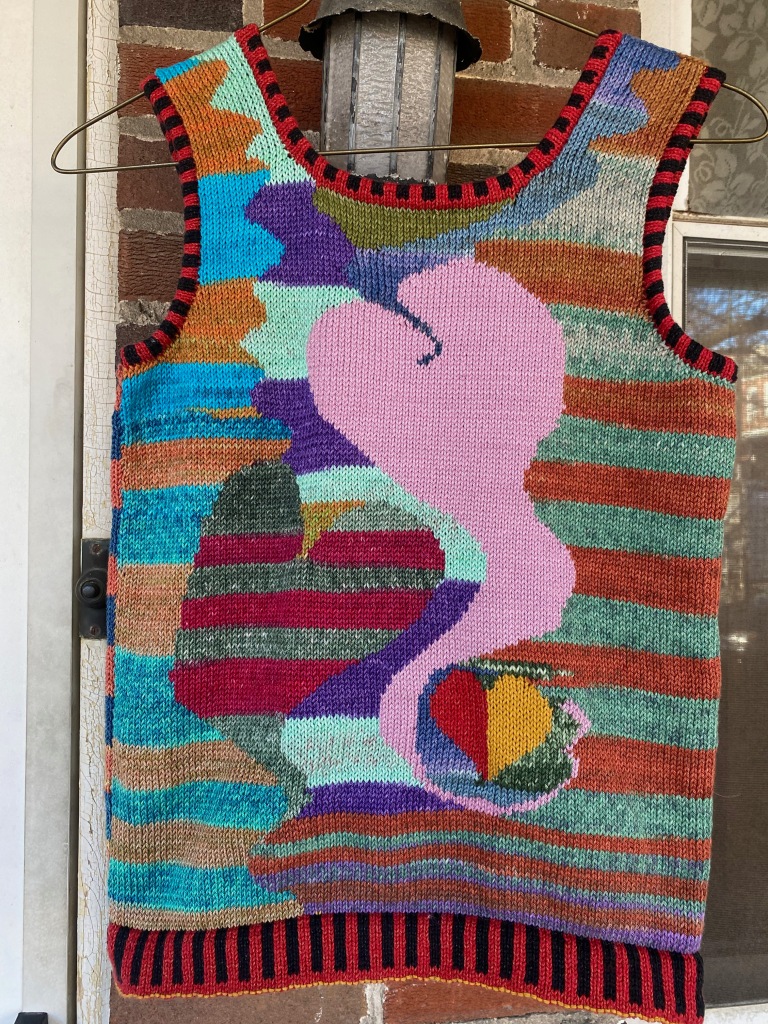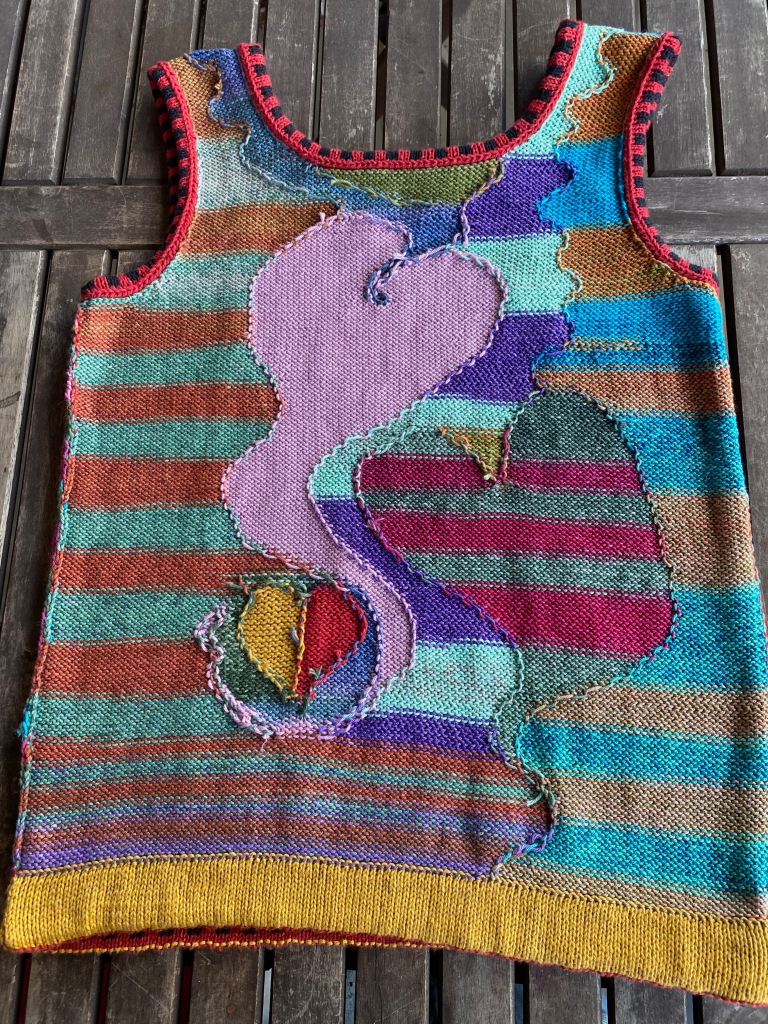Last summer I figured out the mechanics of machine-knit intarsia, and discovered that it was the perfect vehicle for some self-striping mercerized cotton DK yarn that I had had lying around for several years. My first intarsia summer top, made of Uneek Cotton yarn, was supposed to have been a stash-buster, but it came out so well and was so much fun to design with that I am now in the habit of using what I have and then buying more for the next project. I also bought a hand-knitting pattern that had a very usable chart for a heart shape, which I could have charted for myself if I liked charting better, but why reinvent the wheel when someone else has already charted it for me if I just pay them a few dollars for their work?

By the end of the summer, birthday season was looming, with one daughter’s birthday at the end of November and the other daughter’s birthday three weeks later. I began to visualize a sleeveless year-round garment for the December birthday daughter using Uneek Cotton to knit intarsia hearts on the front and back. That idea turned into a winter sweater using worsted weight wool yarn from ancient stash when I had a bit of time to spare at my younger daughter’s house, where I have a medium-gauge LK150 knitting machine, and temporarily had a borrowed intarsia carriage.

What I learned from that project, which I named “The Heart in Winter“, was that placing the top of the heart at the point where the armholes begin creates a sweetheart neckline illusion that one can consider a pleasing design element, or one could find it disturbing. I decided that next time I used the chart, the heart would either decorate the back and not the front, or it would be placed much closer to the neckline, or both.
I wasn’t able to make this summer top in time for the December birthday, but it was still a solid plan with a March deadline, because we have an annual March get-together at my younger daughter’s house in Madison, Wisconsin. I finished my January 2024 Swatchathon and freed up the yarn I needed for the borders of the summer top by finally forcing myself to hand knit the garter stitch edges on yet another Captain shirt, and then I could return to my knitting machine after a break of about six weeks. My plan was to combine my best ideas from Swatchathon 2023: the 2×2 vertical knit-purl stripes from Stitchworld knitted on the fairisle setting, intarsia, and Uneek Cotton self-striping yarn. The stranded vertical stripes would be the edgings at the hem, neck, and armholes, in red and black left over from my long Captain Shirt binge last fall. The Uneek Cotton’s dyed-in stripes in different colorways would provide high contrast and low contrast colorations for the intarsia shapes. I used my intarsia shirt knitted in this yarn as my gauge swatch, and calculated a width of 19 inches per side and a length of 24 inches from the base of the neck to the bottom of the hem.
Since I wasn’t really happy with the positioning of the heart in my older daughter’s winter sweater, I began thinking about using the chart on only one side of the garment and free-forming heart-like shapes on the other side. I decided I wanted to use the chart as a way to organize my thinking about the numbers and dimensions of the garment. Multiplying my desired garment width and length times stitch and row gauge, I knew I needed to cast on 109 stitches and knit 178 rows after a 16-row folded hem in red and black vertical striping. The neck was going to be a 4″ U-neck knitted over 41 stitches and 34 rows, and I wanted to place the top of the neck pretty close to the base of the neck opening. Four rows from the top was right for the last row of the heart, so the neck shaping would start at row 144 and the heart would end at row 140. I built the armhole shaping around the width of the heart, which was 55 stitches. The shoulders were going to be 16 stitches each.
So here were my numbers: total width 109 stitches, heart width 55 stitches. That left me with 54 stitches, 27 on either side of the widest part of the heart. The armhole shaping would be done within those 27 stitches, limited at the other edge by the stitches for the shoulders. I decided that the shoulders would be 16 stitches each, and the width of the shoulders would be limited at the neck edge by the width of the neck, which would be 41 stitches across the center of the work, that is, 20 stitches on either side of the center stitch, where the point of the heart sits. I had 54 stitches on either side of the center stitch, and 54 minus 20 for the neck stitches and 16 for the shoulder stitches left me with 18 stitches to shape the armhole. The depth of the armhole would be 7.5″, 64 rows, starting at row 112, binding off on row 177.
Then I did something really dumb. After I had correctly calculated the length of the heart at 78 rows and 178 rows for the total length of the intarsia part of the piece, and had figured out how to center the heart widthwise, I got the number for the width of the heart, 55 stitches, stuck in my mind and started treating it as the length of the heart, even though I had the correct number, 78, written down on the very page where I was now calculating nonsense. So I started the heart 23 rows higher than I should have and didn’t notice that the heart wasn’t ending where I wanted it until I had finished shaping the armholes and realized I should be much closer to finishing the heart than I actually was. I had to frog 72 rows to get to the place where I should have started the heart. I decided that I couldn’t just take the piece off the needles and quickly rip out the work, because I had to be accurate about my row count and I wasn’t sure I would get the count right if I put in a life line and went bombs away with the ripping. I pulled out the stitches row by row and turned back the row counter every time I took out a row. It took two days to undo two days of knitting. This is why I tell people that machine knitting is much harder than hand knitting.
I wish I understood why the brain has so much trouble recognizing a bad assumption once it believes something false is true. All of my other calculations were mathematically accurate, except for the fact that the fundamental basis for them was dead wrong. I just couldn’t see that it was all wrong until I was getting very close to row 140, where the heart was supposed to be completed, and finally noticed that I still had a lot more heart to knit before I reached the top of the chart. How do you stop a wrong assumption before you get to that point? When I posed this question to the wise ones on my Ravelry group “The Interior of My Brain”, I got some usable suggestions. One person said she explains each step of her thinking out loud to a friend, and the resulting questions can help her identify the fallacies in her thought process. Someone else suggested drawing a schematic of the garment on a white board and writing down the numbers for each segment, and adding them up to compare with the desired total sum. This second option might be more compatible with my way of working, because I think I would just befuddle whoever is unfortunate enough to hear me babbling nonsense that I am deeply convinced of and I would be convinced that their befuddlement was because I wasn’t explaining my sound reasoning clearly. But a diagram and numbers and a calculator might be what I need to cut through the static of self-imposed disinformation.
After this serious bump in the road, things moved along nicely, although not quickly. Machine-knit intarsia is not for the impatient, although the second time through the chart, I learned to mark the margins with the row number to orient me to where I should be and when, which made the knitting process more efficient.

The intarsia for the second piece was completely free-form, so I didn’t have to keep track of any numbers other than what I needed to shape the garment piece. My idea was to grow distorted heart shapes out of squiggly lines while the colors of the self-striping yarn played hide and seek with the red and green heart shape. Meanwhile, the value and hue contrast of the wandering pale mauve heart provided clarity to offset the unclarity of the red and green heart, and the smaller red and yellow bifurcated heart offsets the horizontal striping with a bit of vertical movement that refers logically to the red and black stranded edges. I’m really pleased with the squiggly lines in the top half of the piece. Don’t be surprised if you see variations on this theme in future machine-knit intarsia from me.

Here’s an in-progress picture of the two pieces joined at the shoulder and rehung on the machine across the armhole on both sides of the garment. I was about to knit one row of red while putting the needles into position to knit nine rows of the 2×2 vertical striping in red and black using the preprogrammed Stitchworld pattern. Then bind off in red and whip stitch the edge to the first red row. You can see the inside of the already-finished armhole hanging down behind the ribber at the bottom of the work.

And a view from the inside:


The name of this project, The Heart in Summer, didn’t originally have any particular meaning other than it was a sleeveless cotton top that could be worn in hot weather, and it was a variation on a winter sweater named The Heart in Winter. I made a standard, symmetrical, numbers-based heart shape because I had a chart, and then I made the heart-based variations to play with curved lines and squiggles in intarsia for the fun and mental challenge of getting away from numbers and charts. There wasn’t any symbolic meaning when I first came up with the name and design. But now that it’s done, I can see symbolism that wasn’t part of my original idea. The squiggled and distorted hearts look melted in the heat of summer, the heat of climate change, the heat of emotion, or whatever heat the viewer wants to bring to the interpretation.
Modeled photos of The Heart in Summer on its recipient:




Bonus: photos of the three of us in our Captain shirts.


Excellent work. I love the photo of the three of you together.
LikeLiked by 1 person
Thank you so much!
LikeLiked by 1 person
You have really mastered intarsia. Both front and back (and back and front) are beautiful. I do love the squiggly hearts, though. My eye is always drawn more to asymmetry. And I love that it’s reversible!
I really love intarsia on the machine, because everything is held so neatly in place for you, making it so much easier (I think) to see where the design is going, and what to do next.
The photo of the 3 of you is great.
LikeLiked by 1 person
Thanks, Tanya!!! I definitely prefer knitting intarsia on the machine to hand knitting it.
LikeLike
These sweaters are so cool! Extremely artistic. You have such a flair for design.
LikeLiked by 1 person
Thank you!
LikeLike
Lucky daughters!
I am completely in love with the heart in summer vest!
LikeLiked by 1 person
Thank you so much!
LikeLike